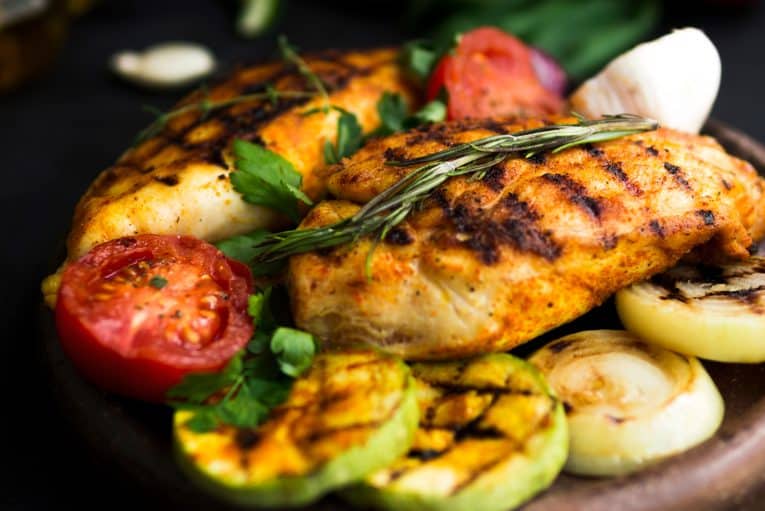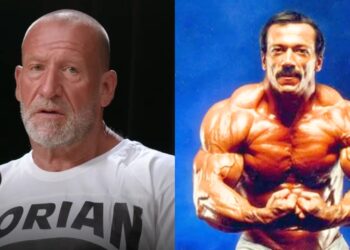“How Many Calories Should I Eat To Gain Muscle?”
This is the million-dollar question.
Most lifters disappointed with their gains blame their lackluster training regimen or, worse, their negligent trainer. They, however, never question their uninspiring diet, which is usually at fault.
Starting training without making adjustments to your diet can help you tone your muscles and shed a little weight due to the newly created calorie deficit because of higher calorie expenditure. You must, however, enter a calorie surplus if you want to build new muscle tissue. A caloric surplus includes eating more calories in a day than you burn.
Strength training, which involves using heavier weights and sticking to the 2-5 rep range, helps build new muscle tissue, resulting in thicker and denser muscles. On the other hand, training for hypertrophy in the 8-12 rep range helps increase the size of the muscle tissue.
Whether your goal is to build denser muscles or rounder or fuller muscle bellies, you must focus on your diet. You break muscle tissue in the gym; they grow back bigger and stronger while you’re resting and have enough calories in your system to support them.
Level Up Your Fitness: Join our 💪 strong community in Fitness Volt Newsletter. Get daily inspiration, expert-backed workouts, nutrition tips, the latest in strength sports, and the support you need to reach your goals. Subscribe for free!
Going hard and heavy in the gym while in a calorie deficit can lead to muscular atrophy, which is counterproductive to your muscle-building ambitions. Managing your calorie intake to gain muscle might feel like walking a tightrope, but we are here to make it easier for you.
This article covers the basics of bulking, the factors that affect calorie intake, how to determine your daily caloric needs, the ideal macronutrient split, the best foods to eat while on a calorie surplus diet, and how to stay on track and monitor your progress.
Bulking in Bodybuilding
Bulking, cutting, and maintenance are the three phases in bodybuilding. Here is an oversimplified explanation of each:
Bulking
The bulking phase includes eating more calories than you expend in a day. This phase lasts anywhere between 4-6 months. You must start the bulking phase with your goal weight in mind. Starting on this path with a clear objective will prevent you from gaining unnecessary weight. Your body will use the additional calories to build muscle mass and strength. [1]
Expect to gain body fat in the bulking phase. You must monitor your progress while eating surplus calories to ensure you don’t head onto the wrong path — more on this later in this article.
Cutting
In the cutting phase, you reduce your calorie intake to shed excess body weight and fat. You can add aerobic and anaerobic cardio training to your exercise regimen to speed up your weight loss.
Since this phase requires you to be in a calorie deficit, it is not inducive to building muscle mass. You will, however, notice improved muscle definition after switching to the cutting phase.
Maintenance
The maintenance phase is also known as the cruising phase. After you have achieved your goal weight and body fat percentage in the cutting phase, you will need to up your calorie intake so that you do not lose additional weight. This is known as the maintenance phase.
You can see the three phases in action by analyzing a professional bodybuilder’s yearly diet changes.
In the off-season, a competitive bodybuilder follows a bulking plan to add muscle mass and new tissue. He switches to the cutting phase, depending on the weight he needs to lose. A bodybuilder must begin the cut 4-5 months before a show if he has more than 20 pounds to shed. A competitive bodybuilder moves to the maintenance phase 1-2 weeks before stepping on stage to work on his conditioning and hardness.
How Many Calories Do You Need To Build Muscle
Determining your daily caloric intake goal for building muscle mass is a multi-step process. Here is a step-by-step guide to nailing your off-season:
1. Know The Average Calorie Intake For Bulking Up
A study review found that, on average, male bodybuilders consumed 3,800 calories, and women consumed 3,200 calories daily during the bulking phase. On the other hand, men ate 2,400 calories and women 1,200 calories in the cutting phase. [2]
Knowing the average calorie intake is the first step in switching to a calorie surplus and will give you a ballpark figure of how many calories you should be consuming to build muscle mass.
2. Factors That Affect Calorie Requirements
Before we get into the nitty-gritty of determining your daily calorie intake goal, you must know that your caloric requirements depend on several factors, including age, gender, body weight, muscle mass, height, and physical activity level. You, however, do not need to make any special adjustments for these factors as our free online calorie calculator uses these inputs to give you an optimized calorie intake goal per your goal.
Find Your Average Daily Calorie Intake
Now that you have a fair idea of how many calories you need, it is time to determine your daily calorie intake goal. Although there are multiple ways of doing this, we’ll introduce you to the two easiest methods.
a. Calculate Your TDEE
Total Daily Energy Expenditure (TDEE) estimates how many calories you burn daily based on four major contributing factors: your basal metabolic rate (BMR), the thermic effect of food metabolism, non-exercise activity thermogenesis, and exercise activity thermogenesis.
TDEE will give you the daily calories you need based on your activity level, ideal weight, BMI score, and macronutrient split for maintenance, bulking, and cutting phases.
TDEE is a one-stop solution for all your caloric needs. Calculating TDEE, however, requires complex formulas and multiple inputs. You can use our convenient TDEE calculator to check how many calories you should eat to gain muscle.
b. Manually Find Your Average Daily Caloric Intake
Calculators are generic, while your body is unique. Each individual responds to calories and exercise differently. You might shed a pound of body weight by doing a 20-minute HIIT cardio session three days a week for five consecutive weeks, while your training partner might need seven weeks to get the same results.
You can achieve better results if you modify your diet based on your lifestyle instead of using a calculator.
Furthermore, if you are a hands-on guy and prefer to avoid calculators, you can use a fairly simple manual process to determine how many calories you need to build muscle mass. However, there is an essential requirement for this process. Your weight must be constant for at least one month. (A 2-5 pound fluctuation is acceptable.)
Here is how to fine-tune your diet plan and add calories to gain muscle:
1. Use a Calorie Tracking App
Although you could do this manually using a notes app on your phone, a calorie tracking app makes it much easier as you do not have to check for each food item’s nutrient information online.
We recommend using MyFitnessPal as it has a vast food database and lets you modify your portion sizes. Once you have installed the app, log your meals for the last five days. Calculate the average of these five days to determine your average daily caloric intake.
Level Up Your Fitness: Join our 💪 strong community in Fitness Volt Newsletter. Get daily inspiration, expert-backed workouts, nutrition tips, the latest in strength sports, and the support you need to reach your goals. Subscribe for free!
Related: How Many Calories To Eat Per Day Calculator
2. Add 500 Calories To Your Diet
Since your weight has been constant for the last month, it is safe to assume that your average five-day calorie intake is your maintenance calories. Now, there are two ways to add calories:
i) Add 500 Calories To Your Average Calorie Intake
Add 500 calories to your daily calorie intake to enter a calorie surplus. Experts believe that adding 500 calories to your daily caloric intake (3,500 calories per week) can help you gain 0.5-1 pound of body weight each week. [3]
You must, however, consider 500 calories as the upper limit, especially if you are just starting. The calories you add to your diet can vary based on genetics, how you react to a calorie bump, how much weight you want to lose, your activity levels, age, and gender.
Easy gainers might experience weight gain even if they add 200 calories to their diet. In contrast, hard gainers might have difficulty adding muscle mass even after spiking their calorie intake by 400 calories.
Conversely, you can switch to a calorie deficit in the cutting phase by gradually cutting 500 calories from your diet.
ii) Bump Up Your Calorie Intake By 10-20%
Increasing your daily calorie intake by 10-20 percent is also a popular method to attain a calorie surplus. For example, if you consume 3,000 calories daily on average, your new calorie intake goal will be 3,300-3,600. [4]
A 300-600 calorie bump can help you gain between 0.4-1.1 pounds of body weight each week. Novice lifters can target the upper spectrum of the calorie bump, while more experienced lifters should favor the lower end, as it will ensure they do not gain excess body fat. [5]
c. Bonus (Get Expert Help)
Learning about calorie surplus for building muscle mass can be intimidating. Plus, getting a calorie surplus right requires trial and error. Folks with jammed pack schedules might lack time to invest in learning about the subject.
Hiring a professional to help you with your transformation goals can save you time and wasted effort. It will cost money upfront but will pay dividends in the long term.
How To Add Calories To Your Diet — Balance Your Macros
After arriving at a new calorie goal, you must break it down into macronutrient ratios to ensure a balanced body composition. Filling the additional calories with fats and carbs can make you gain excess fat, which can be detrimental to your muscle-building goal.
Carbohydrates and proteins contain 4 calories per gram, whereas fats deliver 9 calories. Experts recommend the following macronutrient breakup to build muscle mass: [6]
- Carbs: 45-60%
- Protein: 30-35%
- Fats: 15-30%
Your exact macronutrient ratios will depend on your current physique and fitness levels. You must keep your protein intake at 35 percent to pack optimal muscle mass. Adjust your carbs and fat intake at your discretion.
If you have decided to go with a 3,600-calorie goal, your macronutrient breakup based on the ideal ratios will be:
- Carbs: 405-540 grams
- Protein: 270-315 grams
- Fats: 60-120 grams
Foods To Eat And Avoid For Building Muscle
Many people mistake a calorie surplus for a free pass to eat anything and everything they like. You must, however, ensure that you are consuming high-quality, nutrient-dense foods to achieve your muscle-building goals.
Here is a list of foods that you should and shouldn’t eat on a bulking diet:
Foods To Eat While Bulking
Add the following foods to your grocery list to build quality muscle:
- Meats, poultry, and eggs
- Seafood: cod, crab, lobster, salmon, and tuna
- Dairy: butter, cottage cheese, cheese, yogurt, and milk
- Legumes: black beans, chickpeas, and lentils
- Fruits: apples, avocado, bananas, berries, grapes, kiwi, and oranges
- Vegetables: asparagus, arugula, beets, broccoli, carrots, cucumber, kale, and mushrooms
- Grains: cereals, corn, oatmeal, quinoa, and rice
- Nuts and seeds: almonds, chia seeds, flaxseed, sunflower seeds, and walnuts
- Oils and nut butter: almond and peanut butter, and avocado, canola, and olive oils
Foods To Avoid While Bulking
Stay away from the following foods during the bulking phase:
- Refined carbs: white bread, pizza dough, pasta, pastries, white flour, and sweet desserts
- Alcohol
- Added sugar
- Fried food
Tip: If you’re unsure about eating a particular food while dieting, you should trust your spidey sense and probably avoid it.
Tracking and Monitoring Progress During Bulking Phase
You must constantly record your progress to ensure you’re on the right path. Monitoring your gains will ensure you don’t overdo calorie surplus. Plus, it will help you re-calibrate your methods if your results lag.
Here are four ways to keep a tab on your muscle-building progress:
- Progress Photos and Videos: Visual evidence is an incredibly effective method to ensure you’re moving in the right direction.
- Weigh Yourself: It is a tried-and-true method. You know your diet works if the needle budges in the right direction.
- Analyze Your Training Performance: As you gain weight, you’ll be able to lift heavier for more reps. You might need to up your calorie intake if your strength is stagnant.
- Check Your Body Composition: Body composition tests like calipers, DEXA scans, and bioelectrical impedance devices can help objectively track the changes in your physique.
Remember, you don’t need to log your progress daily. Doing it weekly at the same time will give you all the data you need without making you overly obsessed.
Supplements That Can Help You With Bulking
Entering a calorie surplus requires eating more food, which can be challenging for many people. Supplements can make bulking more manageable by supplying the needed calories in a convenient powder form. We recommend the following supplements for your bulking program:
- Whey Protein: Protein is the building block of muscles. Protein powders help build bigger and stronger muscles.
- Mass Gainers: These contain high doses of carbs and protein, which can help build muscle size quickly.
- Creatine: Creatine works by pulling water into your muscle tissue, effectively building muscle mass. It can also help increase strength and exercise performance.
- Dextrose: Taking dextrose post-workout supplies your muscles with recovery carbs and helps facilitate protein absorption.
Frequently Asked Questions
Is increasing your calorie intake to build muscle mass safe?
Bulking in bodybuilding requires you to follow a calculated calorie increase. Even your cheat meals should be accounted for to ensure you’re not stepping over the line. Increasing your calorie intake to build muscle is safe if you follow a calculated approach and eat nutrient-dense whole foods. Bulking in no shape, way, or form means you can hog on junk food or refined carbs as long as it helps you gain weight.
When should I eat on a bulking plan?
The timing of your meals will depend on your daily calorie goals, muscle-building objectives, and schedule. Ideally, you should consume six to seven small meals at regular intervals throughout the day. Have at least one high-quality protein food with each meal, and eat two hours before and after a workout to maximize your gains.
How to lose the additional muscles gained by following the steps in this article?
Do the opposite of what you did to achieve your gains. For example, if you added 500 calories to your daily calorie intake, cut out the same amount from your diet. Furthermore, you can add a HIIT cardio session to your training regimen to speed up your weight loss results.
Wrapping Up
Beginners and pro bodybuilders in the off-season have one thing in common — they want to gain muscle. Interestingly, whether you started lifting weights this week or have been doing it for multiple years, the process remains the same; you must bump up your calorie intake and follow a rigorous training and recovery program.
Building new muscle tissue requires time and effort. It will test your determination and grit. This article lays out everything you need to know to pack on quality size. Stick to an appropriate calorie surplus, add high-quality foods to your diet, use the recommended supplements, and keep a tab on your progress to build your dream physique. Best of luck!
References
- Iraki J, Fitschen P, Espinar S, Helms E. Nutrition Recommendations for Bodybuilders in the Off-Season: A Narrative Review. Sports (Basel). 2019 Jun 26;7(7):154. doi: 10.3390/sports7070154. PMID: 31247944; PMCID: PMC6680710.
- Spendlove J, Mitchell L, Gifford J, Hackett D, Slater G, Cobley S, O’Connor H. Dietary Intake of Competitive Bodybuilders. Sports Med. 2015 Jul;45(7):1041-63. doi: 10.1007/s40279-015-0329-4. PMID: 25926019.
- Counting calories: Get back to weight-loss basics. (2022, August 24). Mayo Clinic. Retrieved October 8, 2022
- American College of Sports Medicine. American College of Sports Medicine position stand. Progression models in resistance training for healthy adults. Med Sci Sports Exerc. 2009 Mar;41(3):687-708. doi: 10.1249/MSS.0b013e3181915670. PMID: 19204579.
- Rozenek R, Ward P, Long S, Garhammer J. Effects of high-calorie supplements on body composition and muscular strength following resistance training. J Sports Med Phys Fitness. 2002 Sep;42(3):340-7. PMID: 12094125.
- Helms ER, Aragon AA, Fitschen PJ. Evidence-based recommendations for natural bodybuilding contest preparation: nutrition and supplementation. J Int Soc Sports Nutr. 2014 May 12;11:20. doi: 10.1186/1550-2783-11-20. PMID: 24864135; PMCID: PMC4033492.














